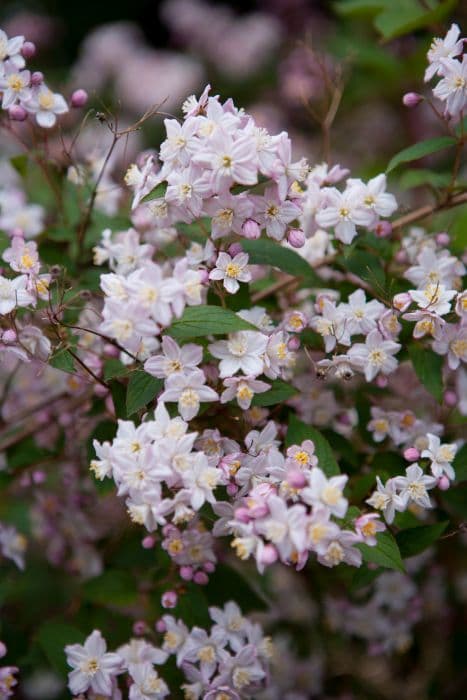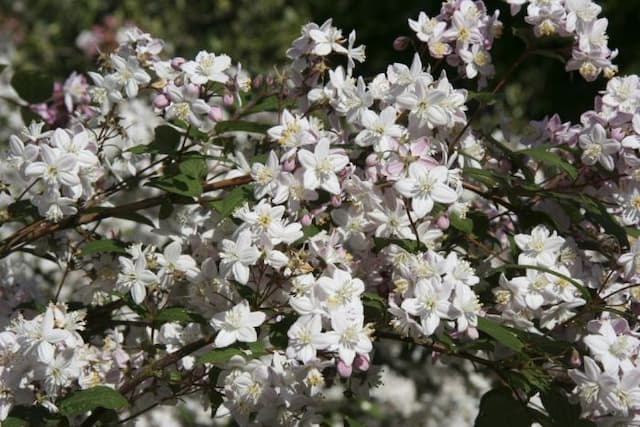Bigleaf Hydrangea Hydrangea macrophylla 'Möwe' (Teller Series) (L)

ABOUT
The Hydrangea macrophylla 'Möwe', commonly known as Lacecap Hydrangea, typically features large, round flower heads that have a distinctive appearance resembling a flat, lacy cap. The 'Möwe' variety, as part of the Teller Series, is known for its striking blooms where the center is densely packed with small, fertile flowers, often a pale color or even blue or pink depending on the soil's acidity. These are surrounded by a ring of larger, showy sterile flowers that can be either of the same hue or display a subtle contrast. These blossoms tend to emerge in early to mid-summer and last for several weeks, providing an enduring display of color. The petals of the larger outer flowers can be broad with a slightly ruffled edge, contributing to the overall soft and delicate texture of the bloom. Lacecap Hydrangeas exhibit rich green, deciduous leaves that offer a lush backdrop to the floral display. The leaves are typically ovate with serrated margins, giving them a somewhat jagged appearance that complements the smoothness of the petals. This plant adds a striking visual interest to gardens, with its flowers not only visually appealing but also attracting pollinators like bees and butterflies. As the seasons change, the flower colors may shift, and the foliage may take on a more muted tone before the leaves fall away in cooler climates. Overall, Hydrangea macrophylla 'Möwe' is celebrated for its captivating, flat-topped flower clusters that bring a unique aesthetic to any planting area where it is showcased.
About this plant
 Names
NamesFamily
Hydrangeaceae
Synonyms
Lacecap Hydrangea, Mophead Hydrangea, French Hydrangea, Bigleaf Hydrangea, Hortensia
Common names
Hydrangea macrophylla 'Möwe' (Teller Series) (L).
 Toxicity
ToxicityTo humans
The common name of Hydrangea macrophylla 'Möwe' is the Bigleaf Hydrangea. Bigleaf Hydrangeas contain compounds that can release cyanide when ingested. While poisoning is rare, ingestion of large quantities can potentially lead to symptoms such as stomach pain, nausea, vomiting, sweating, lethargy, and confusion. In severe cases, ingestion may result in more serious symptoms including difficulty breathing, dizziness, fainting, a rapid heart rate, or convulsions.
To pets
Bigleaf Hydrangea is considered toxic to pets. If a pet ingests part of a Bigleaf Hydrangea, they might experience gastrointestinal upset, which can include symptoms such as vomiting, diarrhea, and lethargy. In severe cases, ingestion can also lead to depression, and more rarely, cyanide intoxication which could be life-threatening if not treated promptly.
 Characteristics
CharacteristicsLife cycle
Perennials
Foliage type
Deciduous
Color of leaves
Green
Flower color
Blue
Height
4-6 feet (1.2-1.8 meters)
Spread
4-6 feet (1.2-1.8 meters)
Plant type
Shrub
Hardiness zones
6
Native area
Japan
Benefits
 General Benefits
General Benefits- Ornamental Appeal: Hydrangea macrophylla 'Möwe' adds visual interest to gardens with its large, showy flowers and attractive foliage.
- Color Variation: The flowers can change color from pink to blue, depending on soil pH, providing a unique aspect to the garden aesthetic.
- Long Blooming Season: It typically blooms from early summer to late autumn, offering a prolonged period of visual enjoyment.
- Ease of Care: This plant is known for being relatively low maintenance, requiring minimal care once established.
- Versatility: It can be used in a variety of garden settings, such as borders, containers, and as a specimen plant.
- Seasonal Interest: In addition to flowers, it can also have attractive autumn foliage colors, extending its seasonal appeal.
- Wildlife Attraction: The flowers can attract pollinators like bees and butterflies, supporting local ecosystems.
- Cut Flower Use: The blooms are suitable for cutting and using in floral arrangements inside the home.
- Can Be Pruned to Shape: It responds well to pruning, allowing gardeners to shape the plant to their desired form.
- Cold Tolerance: It tends to be quite hardy and can withstand cooler temperatures, making it suitable for a variety of climates.
- Potential to Adjust Flower Color: Gardeners can experiment with soil amendments to alter the flower color, making gardening with this hydrangea a more interactive experience.
 Medical Properties
Medical PropertiesThis plant is not used for medical purposes.
 Air-purifying Qualities
Air-purifying QualitiesThis plant is not specifically known for air purifying qualities.
 Other Uses
Other Uses- Hydrangea macrophylla 'Möwe' can be used in dried flower arrangements, with their large, colorful blooms retaining much of their beauty even when dried.
- The wood of old Hydrangea stems is hard and may be carved into small intricate pieces like jewelry or beads for personal use or craft projects.
- The large leaves can be used as a natural wrapping for small gifts or as a unique base for wrapping fish before grilling, imparting a delicate aroma.
- Sometimes used in educational settings, the plant's sensitivity to soil pH (which changes the flower color) can be a practical demonstration of chemistry in nature.
- Artists may use the pigment from the sepals of spent blooms to create a natural watercolor paint, resulting in shades from blues to pinks depending on the pH.
- With their large and attractive leaves, Hydrangea macrophylla 'Möwe' can be used for leaf casting to create decorative garden art or stepping stones.
- The dried root system of a mature Hydrangea macrophylla 'Möwe' might be used artistically in landscaping to create a natural sculpture or a textural garden element.
- In photography, the plant’s vibrant blooms and lush foliage provide a picturesque background for portrait and macro photography.
- Gardeners can use the plant as a teaching tool for topics like pollination and the lifecycle of plants, as it attracts bees and other pollinators.
- For dyeing fabric, the blooms can be boiled to extract a natural dye that will impart subtle colors to textiles.
Interesting Facts
 Feng Shui
Feng ShuiHydrangeas are often associated with gratitude, grace, and beauty, reflecting a harmonious flow of energy when used in Feng Shui. Considering their lush and rounded growth pattern, they can soften the energy in a space. To promote positive energy in the home, place hydrangeas in areas that need an uplift in Wood element, such as the east to enhance family harmony or southeast to boost wealth and abundance. Hydrangeas' varied colors can also impact their use; for example, blue hydrangeas can bring calming energy, which could be beneficial in a meditation space.
 Zodiac Sign Compitability
Zodiac Sign CompitabilityThe hydrangea is not used in astrology practice.
 Plant Symbolism
Plant Symbolism- Heartfelt Emotions: Hydrangeas are often associated with expressing genuine, deep-seated emotions and can symbolize anything from heartfelt joy to gratitude.
- Understanding: The plant is sometimes used to symbolize understanding between people, perhaps due to its lush, full appearance that suggests abundance and empathy.
- Apology/Remorse: In certain contexts, giving hydrangeas may indicate an apology or a representation of regret and a desire for reconciliation.
- Gratitude: The exuberant blooms are also a symbol of thankfulness, making them appropriate for giving as a gesture of appreciation.
- Vanity or Narcissism: Some narratives suggest that hydrangeas can represent vanity or self-obsession, likely linked to the plant's showy, extravagant clusters of flowers.
- Frigidity or Dispassion: In some cultures, hydrangeas can carry a negative connotation of frigidity or lack of romantic interest, owing to historical language of flowers dictionaries.
 Water
WaterBigleaf hydrangeas, like the 'Möwe' variety, prefer consistently moist soil, so it's important to check the top inch of soil regularly and water when it starts to feel dry. This typically means watering once or twice a week, depending on weather conditions. During hot or windy days, you might need to water more frequently. Aim to provide about 1 gallon of water per plant each time you water, ensuring it's evenly distributed around the base of the plant to encourage deep root growth. Avoid overhead watering to keep the leaves dry and reduce the risk of fungal diseases.
 Light
LightBigleaf hydrangeas thrive in locations with morning sun and afternoon shade, as too much direct sunlight can burn their leaves. The 'Möwe' hydrangea does best in dappled or partial shade, particularly in the heat of the afternoon. The ideal spot is one where it's protected from the harsh midday sun but still gets enough light to bloom profusely.
 Temperature
TemperatureThe 'Möwe' hydrangea prefers a temperature range of 65 to 75 degrees Fahrenheit during the day and slightly cooler at night. They can tolerate a minimum temperature of around 50 degrees Fahrenheit but frost can damage the blooms and foliage. Optimal growing conditions are achieved when the temperature doesn't dip below freezing, as prolonged exposure to temperatures below 32 degrees Fahrenheit can be detrimental.
 Pruning
PruningPruning your 'Möwe' hydrangea helps to maintain its shape and encourage blooms for the next season. Prune right after the blooms fade in late summer or early fall, as the plant sets buds for the next year soon after blooming. Remove old, dead wood and trim back about one-third of the living stems to promote vigorous growth and abundant flowers.
 Cleaning
CleaningAs needed
 Soil
SoilThe best soil mix for Hydrangea, commonly known as the Bigleaf Hydrangea, is rich, moist, well-draining, and amended with organic matter. It thrives in soil with a pH that can affect bloom color: a more acidic pH (5.2-5.5) for blue flowers, or a more alkaline soil (up to 6.5) for pink flowers.
 Repotting
RepottingBigleaf Hydrangeas should be repotted every 2-3 years, or when the root system outgrows the current pot. Spring or early summer is the best time to repot for minimal stress on the plant.
 Humidity & Misting
Humidity & MistingBigleaf Hydrangea prefers a humidity level of around 50-60%. This plant benefits from moderate ambient moisture but does not require tropical levels of humidity.
 Suitable locations
Suitable locationsIndoor
Place in bright, indirect light and keep soil moist.
Outdoor
Plant in partial shade, amend soil with organic matter.
Hardiness zone
5-9 USDA
 Life cycle
Life cycleThe life of Hydrangea macrophylla 'Möwe', commonly known as Mophead Hydrangea, begins with germination, where the seed, under the right conditions of moisture and temperature, sprouts and emerges as a seedling. This is followed by the vegetative growth stage, where the seedling develops a root system and foliage through photosynthesis, growing into a mature plant. During spring and early summer, the mature plant enters the flowering stage, producing large, showy flower heads that can be blue, pink, or purple, depending on the soil pH. After pollination, often facilitated by insects, the flowers will give way to seed formation. The plant then enters a period of dormancy during the colder months, conserving energy and resources. Each year, the Hydrangea macrophylla 'Möwe' can go through a similar cycle of growth, flowering, and dormancy, living for many years as a perennial.
 Propogation
PropogationPropogation time
Spring to Summer
The most popular method for propagating Hydrangea macrophylla 'Möwe', commonly known as bigleaf hydrangea, is through semi-hardwood cuttings. This process is typically done in the late summer after the hydrangea has finished blooming. Cuttings should be taken from healthy, non-flowering stems, ensuring each cutting is about 5 to 6 inches long (12.7 to 15.24 cm). The leaves near the bottom of the cutting should be removed and the cut end dipped in rooting hormone to promote root growth. The cutting is then planted in moist, well-draining potting mix, with the bottom third of the cutting buried in the soil. To maintain humidity and encourage rooting, a plastic bag or cover can be placed over the cutting. It usually takes 2 to 3 weeks for roots to form, after which the new hydrangea can be gradually acclimatized to external conditions before transplanting.






![Hydrangea [Early Sensation]](/_next/image?url=https%3A%2F%2Fplants-admin.emdemapps.com%2Fimages%2Fplants%2F%2Fimages%2F604b6150338db.png&w=640&q=75)


